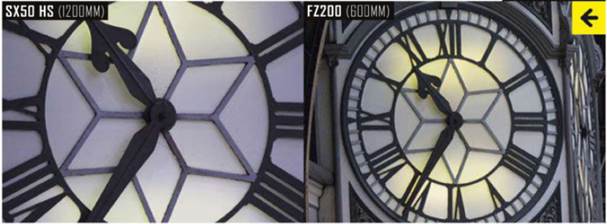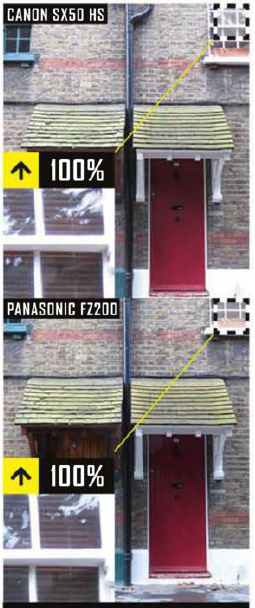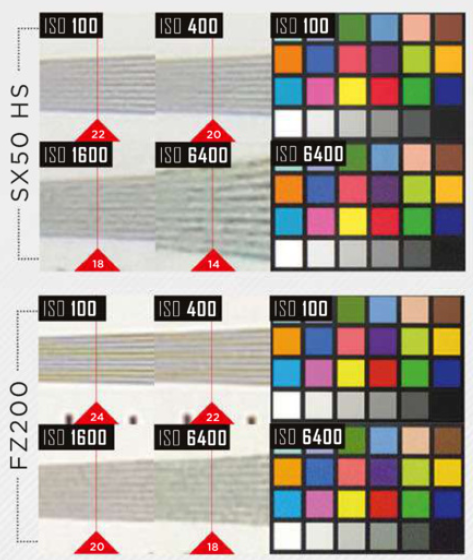A staggering 50x optical zoon on one and a
constant f/2.8 aperture on the other, but which camera wins in the battle for
superzoom supremacy?
Panasonic was one of the first
manufacturers to popularize the idea of a superzoom bridge camera, and its FZ
range has certainly been one of the most successful lines to drive the format
to its current popularity. Externally, its latest Lumix FZ200 iteration adheres
to the recurring superzoom template of small body, substantial zoom range and
plenty of manual control, but it boasts something remarkable: a constant f/2.8
aperture throughout its 24x focal range.
Right now it’s the only camera of its kind
to manage this particular feat, but Olympus, Nikon, Sony and Canon among others
all carry superzoom cameras in their own lines which are comparable in
virtually every other way. The latter manufacturer has been keen to prove it
can successfully follow manufacturers such as Panasonic in providing a credible
alternative, and right now its SX50 HS is the FZ200’s closest match. True, its
aperture may be variable across its zoom range, but with an incredible
24-1200mm focal range it’s likely to attract just as much attention among
enthusiasts.
Features
While the Panasonic FZ200 sports a 25-600mm
f/2.8 lens, the Canon SX50 HS begins its focal range from 24mm and ends it at
1200mm. Each optic sports a necessarily complicated internal construction, with
aspheric surfaces, low dispersion elements and coatings designed to improve
light transmission in each. Thankfully, each manufacturer has been wise enough
to accompany their respective optics with an image stabilization system too,
Canon with its Image Stabilizer and Panasonic with its Power O.I.S. technology.

Optical
Zooms: The images were captured at the longest end of each camera’s lens.
Thanks to the SX50 HS’s maximum aperture of f/6.5 it was necessary to raise the
sensitivity to ISO 1600 in order for the image to be captured sharply
While the two differ with their optics,
they play on more equal ground with their sensors: each measures 1/2.3in and
contains 12.1MP. While the SX50 HS’s sensor spans a range of ISO 100-6400 at
full resolution, the FZ200 begins its range sooner at ISO 80 and only provides
ISO 6400 on an extended setting.
Both manufacturers are keen to stress how
well their respective sensors handle low-light conditions too, which is just as
well considering how small they actually are (on a par with most compact
cameras costing much less.). The sensor inside the SX50 HS boasts a backlit
construction for more effective light capture with the DIGIC 5 processor
helping to minimize image noise. Panasonic doesn’t explicitly state whether its
sensor is backlit or not, but does claim it to have excellent signal-to-noise
capabilities, which are aided further by Intelligent Noise Reduction and
Multi-process Noise Reduction options.

Images
from both cameras are affected by slight chromatic aberration, although the FZ200
tends to display this to a lesser degree
As we would expect, full HD video recording
is available on each camera, with the SX50 HS recording at 24p and the FZ200 in
a choice of 50p and 25p options. Sound is recorded in stereo on both, and each
goes on to provide a couple of slow-motion video modes too. Image stabilization
is also effective in each camera’s movie mode.
The two cameras share a 460,000-dot
resolution for their rear LCD panels, although the FZ200’s display is a touch
larger at 3in, next to the SX50 HS’s 2.8in. The difference between the
electronic viewfinders of the two cameras is considerably greater; while the
SX50 HS’s sees just 202,00 dots over its 0.2in dimensions, the FZ200 bumps this
up to over 1.3million over a slightly larger 0.2in panel.
Each camera’s mode dial reveals a full
complement of exposure options, with the traditional PASM quartet joined by
Auto and Scene settings, as well as two further Custom options on each for
defining and recalling frequently used settings. Raw shooting is also provided
alongside the standard JPE option on each, with Canon’s Raw files saved in the
same. CR2 format as its DSLR, and Panasonic outputting its files into its own
.RW2 format.
In many other respects, the two cameras
more or less match each other. While each sports an integrated flashgun inside
its top plate, each also features a hotshoe for external flashguns and other
accessories. Each also sees a powerful AF assist light incorporated into the
front plate for helping out the AF system in low light.
Both also support the SD, SDHC, and SDXC
trio of memory cards, and both are furnished with USB and HDMI ports at their
sides, although the SX50 HS also adds a port for external remote controls.
Image quality

Color
and white balance
The SX50 HS’s Auto White Balance system is
a little warmer than that of the FZ200, which tends to give neutral (or
near-neutral areas) a yellowy/magenta tinge. The FZ200’s performance here is
not only more accurate but also more consistent, and colors are more life-like.
Exposure
Although both cameras generally do well
with their metering systems, the SX50 HS does have a tendency of overexposing
certain scenes, which forces highlights to be clipped. The FZ200 produces
better-balanced images.
Resolution
Despite the similar resolution, the FZ200
appears to resolve marginally more detail than the SX50 HS. At higher
sensitivities both cameras see a reduction in their ability to do so, but the
FZ200 continues to do a better job.
Image
noise
Images from the two cameras display a
similar – and familiar – pattern whereby noise rises steadily through the
sensitivity range until the last ISO which is significantly worse by
comparison. It’s the FZ200, however, which shows a consistently better
performance throughout the range, particularly at ISO 3200.
Lens
performance
Each camera’s image stabilization system
proves to be effective, and barrel distortion is lower than expected at the
wideangle end of each optic. Chromatic aberrations appear to be more easily
produced by the SX50 HS’s lens (there is some on the FZ200’s lens, particularly
at the telephoto end, but it’s significantly less).
Raw
and JPEG
Both cameras show the smudging effects of
noise reduction if JPEGs next to their Raw files, although the FZ200’s
processing leaves images with better detail at higher sensitivities.
Design
Outwardly, each camera appears to offer
something very similar, but even just a brief time with them uncovers a range
of pleasantries and foibles unique to each. The SX50 HS, for example, contains
a deep groove next to its LCS screen which makes its articulation far easier
than with the FZ200, which only offers two shallow indents on the screen’s top
and bottom that serve little purpose. The SX50 HS also has its menu pad dial
positioned away from the side of the LCD screen, and so has plenty of room for
its side to be pressed comfortably. On the FZ200, the combination of the raised
LCD panel and its proximity to the menu pad can make the same action
irritating.
Where the SX50 HS fall down, however, is
with the actual design of key controls, notably the menu pad dial and mode
dial, both of which would ideally have greater physical prominence for them to
be comfortably operated. The shallowness of the SX50 HS’s grip – particularly
towards its base – also proves irksome, even if you don’t have particularly
large hands. These things leave you with the distinct feeling that there’s just
not enough “camera” to grab on to.
The FZ200’s mode dial is shaped and
finished in a way which makes its operation much more pleasant, while its
rubber-like grip is more refined than the textureless alternative on the SX50
HS (and pleasingly much deeper too). It’s also welcome to see that the mode
dial on each camera rotates around a full 3600, which means you
don’t need to go all the way back through the options to get to the opposite
end. Build quality appears no better on one than on the other, but the varying
finishes on the FZ200 make it more pleasant to use.